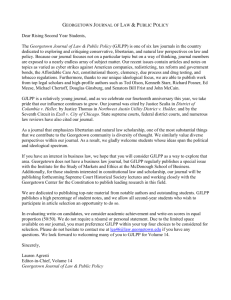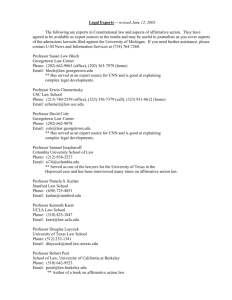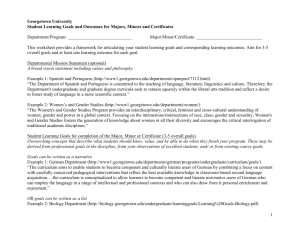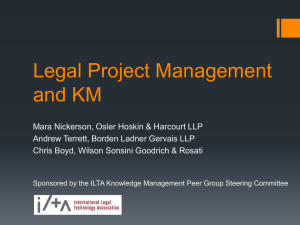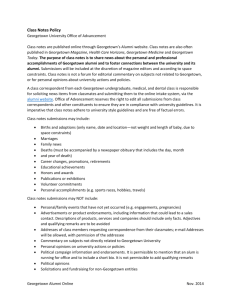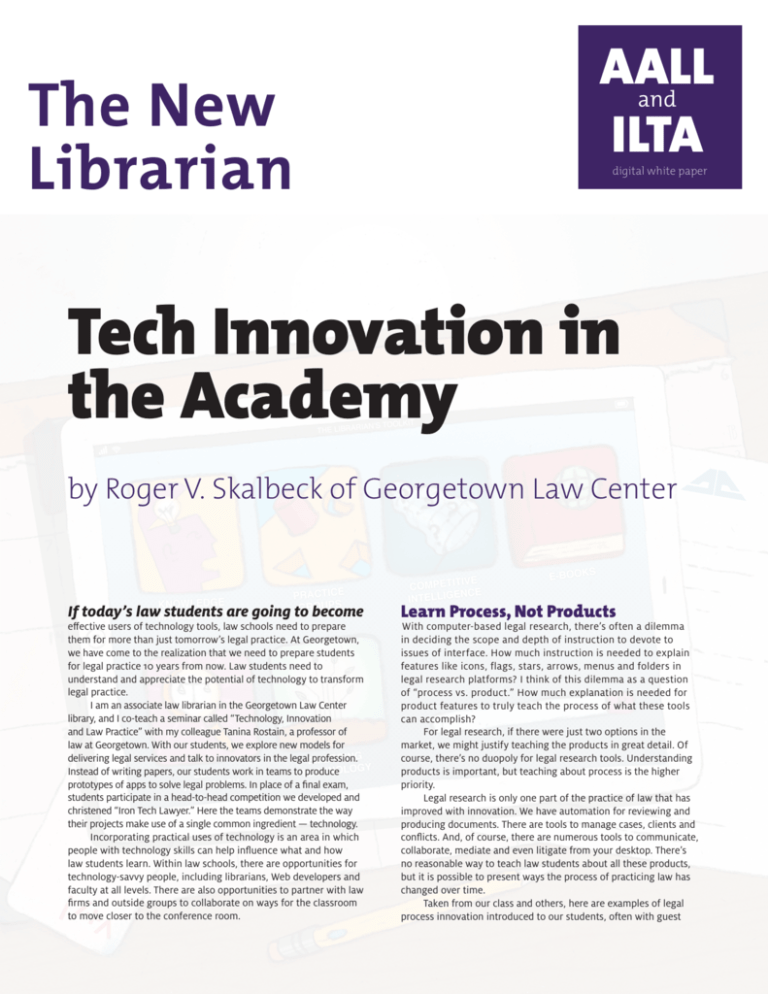
The New
Librarian
AALL
and
ILTA
digital white paper
Tech Innovation in
the Academy
by Roger V. Skalbeck of Georgetown Law Center
If today’s law students are going to become
effective users of technology tools, law schools need to prepare
them for more than just tomorrow’s legal practice. At Georgetown,
we have come to the realization that we need to prepare students
for legal practice 10 years from now. Law students need to
understand and appreciate the potential of technology to transform
legal practice.
I am an associate law librarian in the Georgetown Law Center
library, and I co-teach a seminar called “Technology, Innovation
and Law Practice” with my colleague Tanina Rostain, a professor of
law at Georgetown. With our students, we explore new models for
delivering legal services and talk to innovators in the legal profession.
Instead of writing papers, our students work in teams to produce
prototypes of apps to solve legal problems. In place of a final exam,
students participate in a head-to-head competition we developed and
christened “Iron Tech Lawyer.” Here the teams demonstrate the way
their projects make use of a single common ingredient — technology.
Incorporating practical uses of technology is an area in which
people with technology skills can help influence what and how
law students learn. Within law schools, there are opportunities for
technology-savvy people, including librarians, Web developers and
faculty at all levels. There are also opportunities to partner with law
firms and outside groups to collaborate on ways for the classroom
to move closer to the conference room.
Learn Process, Not Products
With computer-based legal research, there’s often a dilemma
in deciding the scope and depth of instruction to devote to
issues of interface. How much instruction is needed to explain
features like icons, flags, stars, arrows, menus and folders in
legal research platforms? I think of this dilemma as a question
of “process vs. product.” How much explanation is needed for
product features to truly teach the process of what these tools
can accomplish?
For legal research, if there were just two options in the
market, we might justify teaching the products in great detail. Of
course, there’s no duopoly for legal research tools. Understanding
products is important, but teaching about process is the higher
priority.
Legal research is only one part of the practice of law that has
improved with innovation. We have automation for reviewing and
producing documents. There are tools to manage cases, clients and
conflicts. And, of course, there are numerous tools to communicate,
collaborate, mediate and even litigate from your desktop. There’s
no reasonable way to teach law students about all these products,
but it is possible to present ways the process of practicing law has
changed over time.
Taken from our class and others, here are examples of legal
process innovation introduced to our students, often with guest
Tech Innovation in the Academy
lecturers, both remotely and in the classroom. With each, it is
useful to see how an innovative process is implemented; it’s less
important to learn about differences between different products
that perform similar functions.
Predictive Coding and Automated Document Review:
Electronic discovery continues to be a big topic for any ILTA
conference, and litigation lawyers use a variety of partners for
discovery tasks. In class, we go beyond discussing e-discovery tools
and talk about predictive coding, which uses technology to assist
in reviewing, coding and sorting documents for discovery. Maura
Grossman, Litigation Counsel at Wachtell, Lipton, Rosen & Katz,
has talked about her research in this area and provided concrete
examples of successful technology-assisted document review
initiatives.
Unbundling Legal Services: More jurisdictions have begun
to allow lawyers to unbundle legal services, providing options for
lawyers to provide limited-scope representation to more clients.
This is often in the areas of estate planning, wills and some
contracts. Couple these developments with tools for managing
client interaction online, and we have another important process
improved by technology. Students learn far more from seeing the
unbundling process in action than from reading practice rules or
exploring practice support software tools.
The New Normal: Paul Lippe of Legal OnRamp has spoken
with our students about the new normal for law practice and
provided examples from his ABA Journal column. “New normal” as
a buzz phrase has taken hold, but it only makes sense with some
understanding of what normal is or has been. Some students have
questioned what “old normal” was like.
There are many other processes that can be incorporated
into classroom learning. However this is done, it’s important for
students to learn how law firm practice incorporates technology
today, and how it doesn’t. To understand the technology landscape,
look to law firm technology managers, leaders within ILTA and
industry technology surveys for progress benchmarks.
Make Prototypes, Not Papers
In our class at Georgetown, we have students build technology
systems, apps and automated tools to solve legal problems.
Experience with programming languages is neither required
nor expected. At the end of the semester, each team has gained
experience planning, building and explaining what they have done.
Through this process, students consider issues of market demands,
client needs and sustainability of the solutions they build.
A central goal in requiring students to build systems is for
them to develop skills in working with technology. At the complex
end, student groups work with some specific tools and systems
to build their projects. We also require students to present the
prototypes in the “Iron Tech Lawyer” competition at the end of the
course. In the competition, students have to deal with an important
skill: live use of technology in a timed presentation. Each team
has to defend their projects in front of a panel of judges. Students
are judged on presentation skills, application design and overall
effectiveness.
Expert Systems: Expertise First,
Execution Later
Legal expert systems have the potential to simplify legal
problems through a process of breaking down complex rules
into smaller components. An early model for expert systems was
developed and described by Richard Susskind in his dissertation
“Expert Systems in Law.” The system he helped develop dealt
with a complex legal regimen in England that was relatively
rule-based. As is obvious from the name of these systems, they
require a subject-matter expert to input substance to be worth
anything.
At Georgetown, many of our students have worked with an
expert system platform called Neota Logic. This is a sophisticated
platform that supports branched logic, weighted analysis and
customized, input-specific report output. There’s a bit of a learning
curve to working with the authoring tools, and our students wanted
to jump in early to learn all the product features. Initial thinking
was learn the software first, and then apply the legal logic later.
Early on, we advised students that it’s far more important to
understand the logic of a legal regimen than it is to understand the
development tools. By the end of the semester, students working
with these tools appreciated the approach that expertise and logic
come first, with the execution of these rules to follow. Along the
way, their lawyering skills proved critical to creating meaningful
systems.
Expert systems like those from Neota Logic can include
fact-specific reports, where user answers to system questions
help generate a customized report. This requires students to draft
multiple avenues of analysis. Professor David Johnson at New York
Law School likens this to a process of writing 100 different legal
memos. Here again, having legal expertise is a critical component,
where an algorithm isn’t likely to replace an attorney.
Ongoing Initiatives for Innovation in
the Academy
For a broad view of law school efforts to improve student learning
through technology, look for the free e-book: “Educating the Digital
Lawyer,” edited by Oliver Goodenough and Marc Lauritsen. Within
this, there’s a summary from Brock Rutter describing several
existing law school courses that apply technology. This book covers
additional topics, including recommendations for which digital skills
practitioners should have, as well as a host of other topics relevant
to law schools, lawyer learning and today’s needs for technical
application.
One early pioneer to innovate with technology is Professor
Ron Staudt from the Chicago-Kent College of Law, Illinois Institute
of Technology. As Professor Staudt describes, we’ve been on the
verge of a revolution for a few decades. He currently teaches a
technology law practicum that combines classroom learning with
applied law school clinic projects. In this practicum, students
develop technology and justice skills, building useful Web resources
to improve access to justice resources.
Additional courses include:
• Digital Drafting taught by Oliver Goodenough at Vermont Law
School. This course focuses on the evolution of law practice
technologies, including their impact on a broad view of legal
drafting. Students develop programming and automated
drafting skills, work with expert systems, and look at ways that
law practice is transformed in an online environment.
• Lawyering in the Digital Age Clinic offered at Columbia
Law School, where students get hands-on experience using
technologies that are reshaping the legal profession. As an
example, clinic students, working with the New York City
Civil Court have begun to develop an automated system
for tenants involved in eviction proceedings. These projects
are complemented with classroom learning that focuses on
Tech Innovation in the Academy
how technology can assist everything from interviewing and
counseling clients to drafting pleadings and planning strategy.
Law school technology innovation has resulted in more than
just prototypes. A good example is HotDocs. Law schools built that.
Innovation: Not Just for Big Law
AALL
and
ILTA
Incorporating innovation into the practice of law is not just for
big law firms, and it won’t serve exclusively rich clients. There are
some important developments focused on helping legal clinics and
self-represented people. Also, several apps with immense potential
were built by Georgetown students, largely for people who cannot
afford lawyers.
Ron Staudt leads the Center for Access to Justice and
Technology. The Center conducts research, builds software
programs, provides courses and supports students, faculty and staff
with projects focused on access to justice and technology. A very
successful project they’ve developed is the A2J Author platform
(www.a2jauthor.org), which legal aid societies, courts and other
organizations can use to automate interaction with courts. This can
be in the form of guided interviews or assisted document creation
for materials to file with courts. The flexibility of the A2J authoring
tools is expanding, and there are plans to make it available on a
broader range of computer platforms.
Together with Staudt, Marc Lauritsen is pursuing an “Apps
for Justice” program to pilot app development at a few law schools
across the United States, with hopes of expanding this to many
more institutions if the model can be sustained. A core goal
underlying this project is to give more people access to justice and
the court systems.
digital white paper
illustration by thomas boucher, all rights reserved
Roger V. Skalbeck works at Georgetown
Law Center as the Associate Law
Librarian for Electronic Services in the
library. Roger is also an adjunct faculty
member, co-teaching a seminar entitled
“Technology, Innovation and Law
Practice.” He can be contacted at
rvs5@law.georgetown.edu.
OCTOBER 2012
This article was first published in AALL/ILTA’s
October 2012 white paper titled “The New
Librarian” and is reprinted here with permission.
For more information about AALL, visit their
website at www.aallnet.org. For more information
about ILTA, visit their website at www.iltanet.org.
The Future of Innovation in the
Academy
Several law schools continue to pursue new ways for law students
to develop technology skills and prepare for future law practice.
Innovation in the academy is happening, though it isn’t happening
everywhere just yet. To paraphrase William Gibson, maybe the
future of legal education is here, it’s just not evenly distributed.
Here’s hoping more professors, librarians and technology
enthusiasts continue to develop ways to train lawyers for the future.
The New
Librarian
A/I


